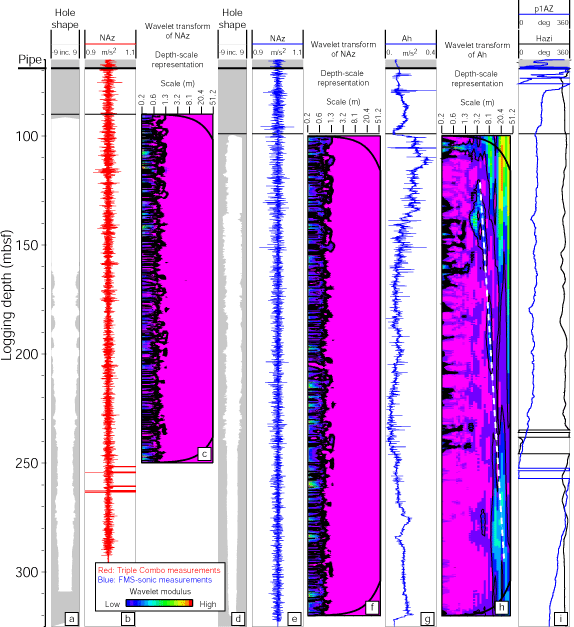
Quality control of the Triple Combo (in red) and FMS-sonic (in blue) acceleration at Hole 1265A. Triple Combo: (a) Caliper, (b) normalized vertical tool acceleration (NAz) and (c) Wavelets depth-scale representation of NAz between 90 and 250 mbsf. The wavelet analysis of the acceleration data allows the multi-scale components of the tool acceleration to be deciphered. The analyzed record (90-250 mbsf) is characterized by acceleration/deceleration mainly over a range < 0.6 m, testifying of almost perfect heave compensation during this run. No intervals of intermediate scale (approximately 4 to 7 m) usually attributed to localized stick-slip displacement over washout are detected. FMS-sonic: (d) Calipers, (e) normalized vertical acceleration (NAz) and (f) depth-scale representation of NAz between 100 and 320 mbsf. The acceleration of the FMS-sonic toolstring remained at levels characteristic of no stick-slip displacement (g) Horizontal acceleration (Ah) and (h) its depth-scale representation. The depth-scale representation is characterized by a progressive decrease in rotation wavelength/smoothness uphole, going from more than 20 m in the upper part of the hole, to 8 m in the middle interval with washouts (170 mbsf – 210 mbsf), to 3 m above. Moreover, the interval above 138 mbsf shows a higher horizontal acceleration as only one axis of the FMS is in contact with the formation. Above 240 mbsf, localized and rapid variations in horizontal acceleration are rare and of low amplitude, and do not impair data quality. As a result, the tool orientation is smoothly guided by the change in hole azimuth (i), and the quality of the microresistivity images is good in the bottom part of the hole and progressively degrade uphole. (i) Hole azimuth (Hazi) and orientation (p1AZ) of the FMS-sonic toolstring. Note the discrepancy between the Triple Combo and the FMS caliper data.
